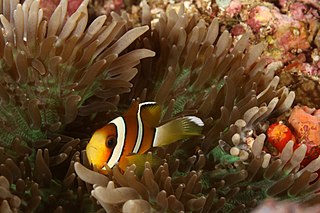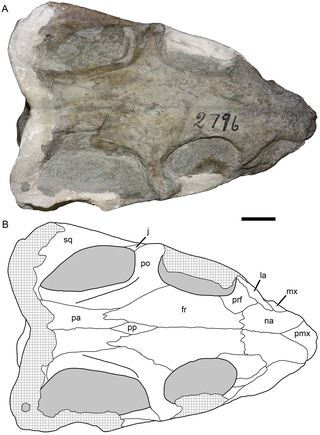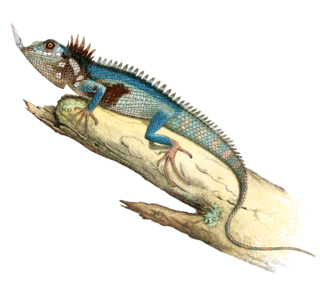
Agama is a genus of small-to-moderate-sized, long-tailed, insectivorous Old World lizards. The genus Agama includes at least 37 species in Africa, especially sub-Saharan Africa, where most regions are home to at least one species. Eurasian agamids are largely assigned to genus Laudakia. The various species differ in size, ranging from about 12 to 30 centimetres in length, when fully grown.

Stegosaurus is a genus of herbivorous, four-legged, armored dinosaur from the Late Jurassic, characterized by the distinctive kite-shaped upright plates along their backs and spikes on their tails. Fossils of the genus have been found in the western United States and in Portugal, where they are found in Kimmeridgian- to Tithonian-aged strata, dating to between 155 and 145 million years ago. Of the species that have been classified in the upper Morrison Formation of the western US, only three are universally recognized: S. stenops, S. ungulatus and S. sulcatus. The remains of over 80 individual animals of this genus have been found. Stegosaurus would have lived alongside dinosaurs such as Apatosaurus, Diplodocus, Camarasaurus and Allosaurus, the latter of which may have preyed on it.

Agamidae is a family of over 550 species of iguanian lizards indigenous to Africa, Asia, Australia, and a few in Southern Europe. Many species are commonly called dragons or dragon lizards.

Harpesaurus is a genus of lizards in the family Agamidae. The genus is endemic to Indonesia.

Pseudocalotes is a genus of lizards in the family Agamidae. The genus is endemic to Southeast Asia.

The eastern bearded dragon, also known as common bearded dragon or simply bearded lizard, is an agamid lizard found in wooded parts of Australia. It is one of a group of species known commonly as bearded dragons. Other common names for this species include Jew lizard and frilly lizard, the latter being a confusion between this and another dragon, the frill-necked lizard. This species was originally described in 1829 by Georges Cuvier, who named it Amphibolurus barbatus.

Calotes calotes, the common green forest lizard, is an agamid lizard found in the forests of the Western Ghats and the Shevaroy Hills in India, and Sri Lanka.

The three-band anemonefish is a species of anemonefish endemic to the Marshall Islands in the western part of the Pacific Ocean. Like all anemonefishes, it forms a symbiotic mutualism with sea anemones and is unaffected by the stinging tentacles of its host. It is a sequential hermaphrodite with a strict size-based dominance hierarchy; the female is largest, the breeding male is second largest, and the male nonbreeders get progressively smaller as the hierarchy descends. They exhibit protandry, meaning the breeding male changes to female if the sole breeding female dies, with the largest nonbreeder becoming the breeding male. The fish's natural diet includes zooplankton.

Ectenosaurus is an extinct genus of marine lizard belonging to the mosasaur family. It is classified as part of the Plioplatecarpinae subfamily alongside genera like Angolasaurus and Platecarpus. Ectenosaurus is known from the Santonian and Campanian of Kansas, Alabama, and Texas.

Gonocephalus chamaeleontinus, the chameleon forest dragon or chameleon anglehead lizard, is a species of agamid lizard from Indonesia and Malaysia.

The Indonesian angelshark is a rare species of angelshark, family Squatinidae, known only from a few specimens collected from fish landing sites in southern Indonesia. It is thought to inhabit the deep waters of the continental slope. Reaching at least 1.34 m (4.4 ft) long, this species has a flattened, ray-like shape and a well-developed tail and caudal fin. It is characterized by the absences of fringes on its nasal barbels and thorns down the midline of its back, as well as by its relatively plain grayish-brown dorsal coloration with dark saddles beneath the dorsal fin bases and a black leading margin on the underside of the pectoral fins. The International Union for Conservation of Nature (IUCN) has classified it as Critically Endangered due to significant fishing pressure.

Prolacerta is a genus of archosauromorph from the lower Triassic of South Africa and Antarctica. The only known species is Prolacerta broomi. Prolacerta was a small and slender reptile, with a rather long neck, low skull, and serrated teeth. It would have resembled a modern monitor lizard at a quick glance, though this is an example of convergent evolution as opposed to close affinities.

Barbaturex is an extinct genus of giant herbivorous iguanian lizards from Pondaung Formation, the Eocene of Myanmar. It is represented by a single species, Barbaturex morrisoni, which is known from several partial dentaries and a fused pair of frontals, two bones that form part of the top of the skull. Based on the size of these bones, Barbaturex morrisoni is estimated to have been about 1 metre (3.3 ft) from snout to vent, and possibly up to 6 feet (1.8 m) including the tail. Barbaturex morrisoni was named after The Doors frontman Jim Morrison, a play on his epithet "The Lizard King". The genus's name is a portmanteau of the Latin words Barbatus and rex, meaning "bearded king", in reference to ridges along the mandible and the lizard's large size.

Anolis proboscis, commonly known as the horned anole, Ecuadorian horned anole or Pinocchio lizard, is a small anole lizard in the family Dactyloidae. A single male specimen was discovered in 1953 in Ecuador and formally described by Peters and Orces in 1956, but the species then went unreported until its rediscovery in 2004. Its currently known habitat is a small stretch of vegetation along an Ecuadorian highway. It has been classified as Endangered by the IUCN due to its restricted distribution and ongoing habitat loss.
Harpesaurus brooksi is a species of lizard in the family Agamidae. The species is endemic to Sumatra.

Thliptosaurus is an extinct genus of small kingoriid dicynodont from the latest Permian period of the Karoo Basin in KwaZulu-Natal, South Africa. It contains the type and only known species T. imperforatus. Thliptosaurus is from the upper Daptocephalus Assemblage Zone, making it one of the youngest Permian dicynodonts known, living just prior to the Permian mass extinction. It also represents one of the few small bodied dicynodonts to exist at this time, when most other dicynodonts had large body sizes and many small dicynodonts had gone extinct. The unexpected discovery of Thliptosaurus in a region of the Karoo outside of the historically sampled localities suggests that it may have been part of an endemic local fauna not found in these historic sites. Such under-sampled localities may contain 'hidden diversities' of Permian faunas that are unknown from traditional samples. Thliptosaurus is also unusual for dicynodonts as it lacks a pineal foramen, suggesting that it played a much less important role in thermoregulation than it did for other dicynodonts.
Harpesaurus beccarii, also known commonly as the Sumatra nose-horned lizard or the Sumatran nose-horned lizard, is a species of lizard in the family Agamidae. The species is endemic to Sumatra, Indonesia.
Harpesaurus borneensis is a species of agamid lizard. It is endemic to Indonesia.
Harpesaurus ensicauda, the Nias nose-horned lizard, is a species of agamid lizard. It is endemic to Indonesia.

Harpesaurus modiglianii, also known commonly as Modigliani's nose-horned lizard, is a species of lizard in the family Agamidae. The species is endemic to Indonesia.















